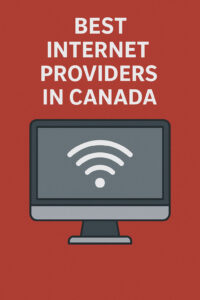Switching internet providers in Canada can feel overwhelming, especially if you are concerned about losing connectivity during the process. Whether you are moving, looking for better pricing, or simply unsatisfied with your current provider, switching can be done smoothly if you plan strategically. This guide outlines the essential steps to change your internet provider without any service interruption.
Understand Why You Are Switching Providers
Before initiating a switch, be clear on your reasons. Are you frustrated with slow speeds, high costs, poor customer service, or limited features? Identifying your core reason will help you choose a better provider that aligns with your needs. Use this opportunity to reassess what you actually need from your internet plan: is it unlimited data, faster upload speeds, or bundled services?
Compare Internet Plans in Your Area
Use online tools like Stackup.ca or Findhub.ca to compare internet plans from various ISPs in your city. Providers often vary by region, especially in rural areas. Ensure the new provider covers your address and offers the right balance of speed, reliability, cost, and customer reviews. Look into both large providers like Bell, Rogers, and Telus, and smaller, more flexible ISPs like Diallog, Coextro, and Cannet.
Check Your Current Contract and Fees
Before cancelling, read the terms of your existing agreement. Many internet contracts include:
- Early Termination Fees (ETFs): Some providers charge a fee if you cancel before your contract ends.
- Equipment Return Clauses: Modems, routers, or other hardware must be returned to avoid charges.
- Notice Periods: Some contracts require you to give 30 days’ notice before cancellation.
If your contract is nearing the end, this could be the ideal time to switch and avoid penalties.
Schedule Your New Installation Before Cancelling
This is the most critical step to avoid downtime. Do not cancel your current service until your new internet service is fully installed and tested. Most Canadians who lose service during a switch do so because they cancelled before their new provider completed installation. Coordinate with your new provider to install their service on a specific date, ideally during off-hours when internet usage is low at your home or business.
Ask for a Temporary Overlap Period
If financially viable, request a temporary overlap period of a few days where both services run simultaneously. This ensures a buffer in case there are delays with the new provider. During this window, test the new connection’s speed, stability, and compatibility with your home setup (Wi-Fi devices, smart TVs, home security systems, etc.).
Transfer or Replace Your Modem and Router
Depending on your new provider, you may need to either return your old equipment or purchase new hardware. Some ISPs offer compatible routers or allow you to use your own. Make sure to:
- Check if your existing modem/router is compatible with the new provider.
- Request a self-install kit or professional setup if needed.
- Update your home Wi-Fi name (SSID) and password if hardware changes, to avoid reconnecting all devices manually.
Port Your Home Phone Number (If Applicable)
If you have a home phone bundled with your current internet and want to keep your number, make sure the new ISP supports number portability. Do not cancel your old service until the number is successfully ported over. Losing your phone number during a switch is often irreversible.
Inform Household Members and Update Devices
Let everyone at home or in the office know about the upcoming switch. Ask them to save any work in progress during the installation window. Devices like smart thermostats, speakers, or security cameras may need reconnection. Update all devices to the new Wi-Fi credentials if applicable.
Test Your New Connection Thoroughly
Once your new service is live, test everything:
- Run a speed test to verify promised speeds.
- Check Wi-Fi coverage in all rooms.
- Use video conferencing and streaming platforms to ensure stability.
- Try uploading and downloading large files.
If any issues arise, contact the provider’s tech support before cancelling your old service.
Cancel Your Old Internet Provider
After your new service is tested and running, contact your old provider to officially cancel. Ask for a final bill and ensure that all equipment has been returned and your account is closed. If you are under contract, negotiate fees or ask if they offer a retention deal, though do not accept it unless it clearly benefits you more than the switch.
Take Advantage of New Promotions
New customers often get discounts, free installations, or bonus data. Make sure you claim all introductory offers and ask about referral programs. If your previous provider tries to win you back, get their offer in writing and compare again. Sometimes the best deals come when you are about to leave.
Common Mistakes to Avoid When Switching Internet Providers
- Cancelling too early: Always wait until the new service is live before cancelling the old one.
- Ignoring contract details: Early termination fees can wipe out your savings if not accounted for.
- Overlooking equipment needs: Not all routers work with all ISPs. Always verify compatibility.
- Assuming Wi-Fi names stay the same: Update your network name and password to maintain seamless connectivity.
Tips for Businesses Switching Internet Providers
Businesses have even more at stake when switching internet providers. A short disruption can impact operations, customer service, or data backups. Consider the following:
- Schedule installations during non-working hours.
- Keep IT staff on-site during the switch.
- Use mobile hotspots as a backup.
- Test VoIP phones and internal networks after the switch.
Final Thoughts: Stay Connected Without a Hitch
Switching internet providers in Canada is simpler than most assume, as long as you take the right steps. By aligning the timing of cancellation, verifying compatibility, testing the new setup, and using a short overlap period, you can maintain uninterrupted service. Whether you are seeking faster speeds, better customer support, or simply lower costs, switching is a powerful way to stay in control of your internet experience.
Use trusted comparison tools like Stackup.ca or Findhub.ca to get started on finding the best ISPs near you.






